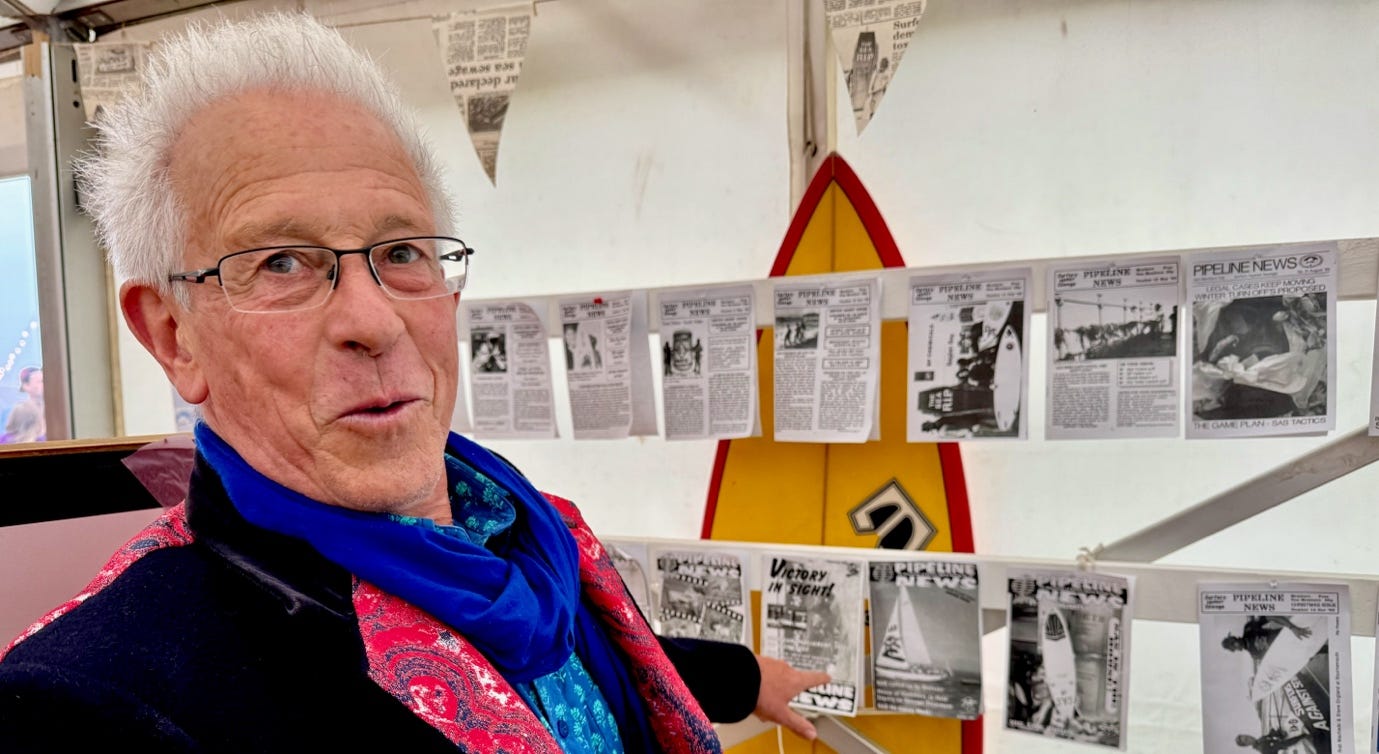A lone piper skirled as we walked through ground-hugging cloud to a circle of tented stages atop the headland of Cornwall’s St Agnes Beacon. The sea was out there somewhere, wreathed in vapor. It was Saturday, 5th July, and Surfers Against Sewage (aka SAS), one of my very favorite NGOs, were holding their 35th Anniversary Ball.
I was slated to speak in one of the tents—billed as “The Anarchist’s Arms”—about how we must all learn to surf the future, alongside two former SAS CEOs and the current one.
But as we passed the cloud-cloaked piper I wondered whether I might be hearing a lament for the fading power of NGOs worldwide? Cast adrift in a world of autocrats with an intense hatred for democratic process and an instinctive hostility to independent voices.
This gloomy thought surfaced because a key finding of a new global survey of sustainability professionals which we—that is, GlobeScan, the ERM Sustainability Institute and Volans—launch on 15th July suggests that confidence is waning in the ability of NGOs to drive change.
As the trends map from 2012 to 2025 shows, only “research and academic organizations” seem to be resisting the generally downward spiral in civil society’s perceived ability to drive change.
Not pretty—waning faith in civil society organizations (source: Sustainability At a Crossroads, 2025)
I don’t think there’s a secret recipe for turning the corner in each of these sectors, but the SAS event reminded me of some of the reasons I admire them so much—and suggested clues as to how other activists might find their way through the current miasma into brighter, more hopeful futures.
By the end of the evening, I may have been both considerably colder and damper, but I my mind had shifted fully 180 degrees. In the new reading, those skirling pipes became a call to arms for all would-be changemakers—signalling the growing need to disrupt and update civil society organizations to force and chivvy markets and businesses in more sustainable directions.
How to blow up a mindset
If I have a theory of change, it begins with scientists doing the science, continues with campaigners and activists agitating to get the media to broadcast the story to the public and then sees concerned populations bringing political pressure to bear on key decision-makers. Healthy societies and healthy markets depend on civil society organizations.
That’s the spirit in which everyone from the anti-slavery campaigners to civil, human and animal rights activists have gone about driving and shaping change. If you doubt it, read Andreas Malm’s riveting book, How to Blow Up a Pipeline.
Given how important the role of NGOs is in this model, you won’t be surprised to hear that this isn’t the first time I have zeroed in on how they operate—and how they might boost their impact. Such themes have run through most of my books—and, back in 2003, my previous company, SustainAbility, published a landmark study of the forward challenge for NGOs, called The Twenty-First Century NGO: In the Market for Change.
Although by no means universally popular, we concluded, NGOs, NGO-like organizations and civil society organizations (or CSOs) were playing an increasingly vital role in democratic and democratizing societies. Governments and business might resist their advocacy, but there was real interest in the potential roles NGOs might play in developing and deploying solutions. As a result, a new market-focused opportunity space is opening up, but this often requires solutions that are not simply based on single-issue responses.
This, we argued, represented a challenge even for most mainstream, well-resourced NGOs, so public and private sector partnerships are increasingly essential in leveraging change.
In the process, we saw new forms of competition evolving in the ‘NGO market’, with new entrants like companies, business networks, NGO networks and social entrepreneurs blurring traditional boundaries. Both national and international NGOs, as a result, were having to pay more attention to the whole area of branding and competitive positioning.
Within months of the report launching, I found myself doing in person board briefings for NGOs like Oxfam International, Transparency International and WWF international. But my links with SAS already tracked back a decade earlier.
When Julia Hailes and I launched our book Holidays That Don’t Cost the Earth, the event was held in the Porchester Spa, London’s oldest spa, and featured celebrities people like Douglas Adams, of Hitchhiker’s Guide to the Universe fame, and Chris Hines, co-founder and director of Surfers Against Sewage.
Eye-catchingly, Chris turned up in a wetsuit, clutching his surfboard—and draped in condoms and panty liners, the sort of thing surfers encountered routinely in the waves around the British coastline.
The SAS story
So how did Surfers Against Sewage start? Founded in 1990 by a Cornwall-based group of surfers, it’s a UK-based marine conservation and campaigning charity that surfaced as a response to severe sewage pollution affecting Britain's coastlines.
Initially focused on water quality issues, particularly raw sewage pumped into the ocean, SAS has evolved into a broader movement focused on ocean and coastal protection, coordinating a large and active community of ocean activists.
The timing was auspicious, it turned out. The government’s privatization of water companies in 1989, along with new environmental legislation like the Urban Wastewater Treatment Directive in 1991, provided opportunities for SAS to campaign for change.
Early SAS campaigns were known for their direct action and use of visual and often irreverent tactics, including using gas masks and inflatable turds in protests. Indeed, The Times ran a story with exactly that sort of image a few days before the 35th anniversary Ball opened for celebration.
SAS successfully pressured water companies to invest in improved sewage treatment and helped steer them away from the "pump and dump" mentality. Since then, the organization has expanded its scope to address a wider range of threats to the ocean, including plastic pollution and other forms of marine pollution.
But the statistic that had stuck in my mind for a while is that SAS managed to steer no less than £5 billion of investment into cleaning up the water and sewerage sectors in the UK.
Sadly, however, the old menaces are back, partly because of poor regulation of the industry, partly because of the venality of those managing many of the water companies since privatization, and partly because climate change is intensifying rainfall patterns—overwhelming current infrastructures.
So, what do the next 35 years hold?
I think this may have been the first time where I had shared sofas with three people who had run the same organization. The sofas were well-used (to put it politely) Chesterfields, rounded up for the occasion—and we sat up on their backs, to better engage the audience.
Looking out on a sea of heads, many in deckchairs and in fancy dress, I kept a weather eye out for some of the human, shark and lobster heads I had seen around the site—with the odd jellyfish thrown in for good measure.
The rapid-fire exchange on the sofas was full of energy and optimism, with a strong sense that there will still be a need for SAS—and organisations like it—in 35 years. So here are some thoughts conjured—and images captured—along the way.

Among the themes we discussed in the “Surfing the Future” session was the extraordinary community SAS has built over the decades, with the 2,000-odd people turning up for this year’s Ball spanning the spectrum from babes in arms through to the grey and grizzled—even if some of them gave a new meaning to the term glitterati.
But no amount of glitter can hide the fact that water sector reform in England and Wales is now, once again, a looming challenge. When the Independent Water Commission delivered its interim report last month, SAS CEO Giles Bristow publicly warned that it risked merely “tinkering around the edges” of a system that he described as fundamentally broken.
Profiteering water companies
The facts confirm the bleak analysis. Since privatisation in 1989, water companies in the UK have amassed debts of over £69 billion, whilst paying out over £72.9 billion in dividends to shareholders. In 2024, water companies across England announced customer bills would increase by an average of 36% over the next five years—yet in the same year sewage was discharged over half a million times into UK waters, and shareholders of private water companies received £1.2 billion in payouts.
SAS data show that, in 2025 so far, sewage has poured into British waterways over 158,000 times, with over 500 people reporting via the app that they have become sick after using the water since January. Between January and June, there were 54 days where over 1,000 discharges occurred in a single day.
As Giles summed up the problem: “Public trust in our profiteering water companies is in tatters, yet the Independent Water Commission still clings to the ideological delusion that our profit-before-people privatised system can be fixed. The solution is simple: water companies need to be restructured to operate for the public good, not private profit. For as long as the core aim of the water industry is to make profit, our seas will continue to fill with sewage whilst the fat cats’ pockets fill with dirty money.”
Our 45-minute session concluded that the next 35 years must see radical transformation of the water sector. And that the aim of NGOs like SAS must now be system change—not as in let-all-hell-break-loose forms of anarchy, but with sustained, strategic and systemic pressure applied to critical leverage points over time.
All of which might have had some of those quaffing locally brewed, organic beers recharging their beakers and heading off to listen to the sea shanties next door or bands like The Oggymen or Dreadzone.
But for me, at least, the extraordinary charm of Surfers Against Sewage is its sense of humor, its playfulness and the joy that members show in interacting with and campaigning for the natural world.
Some final thoughts
Finally, here, if I had to sum up my current take on the challenge for CEOs, it would involve three suggestions:
First, acknowledge that tinkering and incremental change are no longer enough, if they ever were. As our impending Sustainability At A Crossroads survey report underscores, anyone paying attention understands that we now need radical, systemic change.
Second, talking about the need for systemic change only gets you so far. If you want real impact, you must zero in on specific parts of the economy, developing an acute understanding of the political and market contexts in which they operate—and then working the relevant leverage and pressure points to the point where the incumbents turn turtle and give up.
And third, whatever you are doing, make it engaging for the rest of us, for ordinary folk. Build and nurture grassroots support wherever you can. Give supporters opportunities to get actively involved. And, even if the cloud reaches down to your ankles and the storm overhead is thumping down on the roof of your tent, make it a joy to be part of. To sustain the necessary level of effort over the necessary expanses of time, most of us will need some fun along the way.
P.S. Huge thanks to Chris Hines for inviting me to the Ball and for putting me up on the very spot where SAS was birthed—and to Volans CEO Louise Kjellerup Roper and her husband Mark for being joyfully part of it all, too.
















I agree the struggle NGOs face is definitely a real one especially when many voices are asking for the same discussion points and vying for the same pots of funding. My thoughts on this are definitely ones of not just fighting for a radical system change but finding a way for radical collaboration.
It was a joy to talk so much on Saturday. Thanks again.
"If I have a theory of change, it begins with scientists doing the science, continues with campaigners and activists agitating to get the media to broadcast the story to the public and then sees concerned populations bringing political pressure to bear on key decision-makers. Healthy societies and healthy markets depend on civil society organizations."
Love this John. Like Yvette in this thread, I worry that there is far too much duplication in the NGO/CSO/Charity space. It causes confusion, dilution, and exceptional pressure on reducing funding pots.
But, BUT, NGOs are a vital element of your ToC...if governments and corporates acted responsibly in the first place we wouldn't need them.